The history of fluid art is a mesmerizing tale that takes off in the 1930s with David Alfaro Siqueiros, who experimented with paint pouring and spontaneous designs. His pioneering spirit was like a splash of color onto the art world canvas, especially impacting artists like Jackson Pollock. Acrylic paints, taking center stage in the 1950s, made fluid art more accessible, setting off a wave of artistic innovation. Imagine the excitement of blending paint densities and watching colors create stunning patterns—it's like magic with a brush! Step by step, you'll discover more about how fluid dynamics and creative minds revolutionized art.
Key Takeaways
- Fluid art began in the 1930s with David Alfaro Siqueiros' pioneering paint pouring techniques focused on color interactions.
- The invention of acrylic paints made fluid art more accessible, leading to new methods like paint pouring and abstract expressionism.
- Siqueiros' accidental painting techniques and experiments with paint additives significantly influenced future artists, including Jackson Pollock.
- Pollock's drip and pour techniques during the 1940s-1960s became central to Abstract Expressionism, promoting fluid acrylics in mainstream art.
Origins of Fluid Art
The origins of fluid art can be traced back to the 1930s, with Mexican artist David Alfaro Siqueiros pioneering early paint pouring techniques that emphasized the dynamic interactions of color. Siqueiros introduced the world to 'accidental painting,' where the natural flow and mixing of paints created beautifully unpredictable designs. This technique allowed artists to explore a new domain of emotional expression, as the spontaneous nature of the process mirrored the unpredictability of human emotions.
It also provided unprecedented artistic freedom, liberating artists from traditional methods and encouraging them to experiment with the fluidity and movement of paint.
The early 20th century saw the invention of acrylic paints, which revolutionized the world of painting. These new paints were more accessible and affordable, making fluid art techniques more widespread.
The combination of art and science, particularly through the study of fluid dynamics, influenced how artists understood the behavior and layering of paint. Jackson Pollock, who studied under Siqueiros, took these fluid techniques to new heights, contributing greatly to the development of Abstract Expressionism.
Role of David Alfaro Siqueiros
David Alfaro Siqueiros was a trailblazer in the world of fluid art, creating a technique called 'accidental painting' that used innovative paint pouring methods in the 1930s.
By experimenting with different paint additives, he managed to change how thick or runny the paint was, leading to some pretty amazing color effects on canvas.
His groundbreaking work had a big impact on future artists, including the famous Jackson Pollock, showing how art and science can come together in exciting ways.
Pioneering Accidental Painting
In the 1930s, Mexican muralist David Alfaro Siqueiros revolutionized art with his pioneering technique of 'accidental painting,' which employed spontaneous paint pouring and dynamic color interactions. This method broke away from traditional painting techniques, introducing an element of artistic spontaneity that was both thrilling and unpredictable.
Siqueiros believed that allowing the paint to flow freely on the canvas created a more organic and lively interplay of colors. He would pour, drip, and splash paint, letting gravity and fluid dynamics take over. This approach resulted in vibrant, swirling patterns that seemed to come to life on their own, showing how color interaction could be more than just a planned element, but a dynamic process.
Teaming up with his girlfriend, Sandra Cetina, Siqueiros explored the science behind these phenomena. They investigated the principles of fluid dynamics, studying how different densities and viscosities of paint could create unique effects. Their experiments were groundbreaking, merging art with scientific inquiry.
Siqueiros's innovative techniques not only influenced his contemporaries but also paved the way for future artists like Jackson Pollock. His work demonstrated that understanding the science of fluids could open up new domains of artistic expression, making accidental painting a significant milestone in the history of fluid art.
Experimenting With Paint Additives
Pioneering the field of fluid art, Siqueiros explored the use of various paint additives to manipulate viscosity and density, achieving remarkable and unpredictable effects. He was a true experimenter, diving into the world of paint viscosity and density with enthusiasm. By adding substances like lacquer and oils to his paint mixtures, Siqueiros could control how thick or thin the paint was, leading to some pretty amazing results. Imagine watching colors swirl together in unexpected ways, creating new textures and patterns right before your eyes – that's the kind of magic Siqueiros brought to fluid art.
Siqueiros didn't work alone; he teamed up with his girlfriend, Sandra Cetina, and even collaborated with a physicist to better understand the science behind their experimental techniques. Together, they studied how different paint densities interacted during the pouring process. This was no small feat, as they were fundamentally turning art into a scientific exploration. Their findings on how additives influenced cell formation and texture were groundbreaking at the time.
Thanks to Siqueiros' fearless experimentation, fluid art took on a new dimension, showcasing that art could be both beautiful and scientifically fascinating. His innovative spirit set the stage for future artists to keep pushing boundaries.
Influencing Future Artists
Siqueiros' groundbreaking work in fluid art not only transformed the medium itself but also profoundly influenced subsequent generations of artists, including notable figures like Jackson Pollock. Siqueiros introduced the world to 'accidental painting,' where the spontaneous interactions of paint create one-of-a-kind designs. This idea captivated the fluid art community, sparking widespread interest and experimentation.
Siqueiros's collaboration with physicist Sandra Cetina was particularly game-changing. Together, they explored the science of fluid dynamics, examining how different densities and viscosities of paint could yield spectacular results. This artistic collaboration laid the groundwork for many techniques that artists still use today. Imagine the excitement in their studio, as they observed how a slight tweak in paint consistency could produce a whole new visual effect!
One of his most famous students, Jackson Pollock, took these lessons to heart. Pollock's signature drip paintings owe much to Siqueiros's methods, marrying fluid art with the explosive energy of abstract expressionism. Thanks to Siqueiros, future artists felt empowered to push boundaries, blending art and science in ways that continue to inspire.
Today, his legacy thrives, as members of the fluid art community carry forward his spirit of innovation and fearless experimentation.
Early Acrylic Paint Innovations
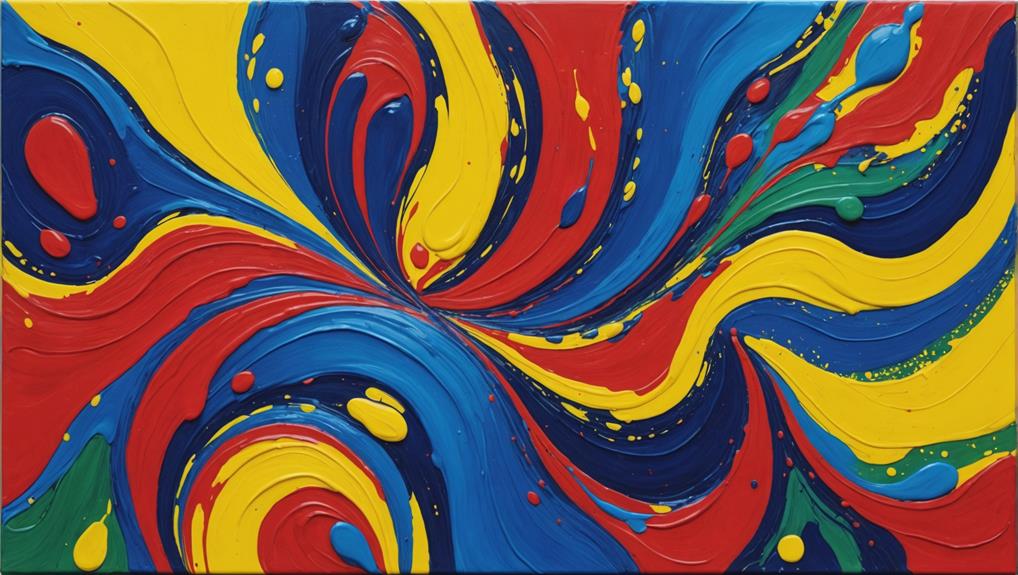
The invention of acrylic paints in the early 20th century brought a wave of creative freedom to artists, giving them a fast-drying and versatile medium to experiment with.
Pioneers like David Alfaro Siqueiros pushed the boundaries by using liquid acrylics in groundbreaking ways, leading to the development of fluid art techniques.
This innovation transformed art practices, allowing for new methods such as paint pouring and abstract expressionism, which continue to inspire artists today.
Invention of Acrylic Paints
Artists in the early 20th century experienced a transformative shift with the invention of acrylic paints, which reached significant milestones in the 1930s. This period marked an essential phase in acrylic evolution, as chemists and artists collaborated to develop innovative paint formulations. These new paints were groundbreaking, offering a fast-drying alternative to the traditional, slower-drying oil paints that had dominated the art world for centuries.
The first commercially available acrylic paints were introduced by Liquitex in 1955, making them accessible to a broader audience. This accessibility allowed a more diverse group of artists to experiment with the medium, leading to a surge in creative exploration. Acrylics are water-based, which means they dry quickly and clean up easily with water, eliminating the need for harsh solvents. This convenience was a game-changer for many artists, who could now work more spontaneously and efficiently.
Moreover, the ability to mix acrylics with various additives, such as mediums and gels, provided artists with unprecedented control over paint viscosity and texture. This versatility and the vibrant colors of acrylic paints contributed to their popularity in both fine art and craft applications, ultimately paving the way for the development of fluid art techniques.
Pioneers in Fluid Art
Mexican artist David Alfaro Siqueiros revolutionized early acrylic paint innovations by pioneering fluid art techniques in the 1930s, which introduced the concept of 'accidental painting.'
Siqueiros was a trailblazer in experimenting with fluid techniques, where he played with paint additives to manipulate viscosity and density. This approach allowed for more dynamic interactions of colors on the canvas, creating unpredictable and mesmerizing patterns that embodied artistic expression.
Siqueiros' innovative spirit extended into scientific explorations alongside his girlfriend, Sandra Cetina. Together, they explored the world of fluid dynamics, focusing on how the density and viscosity of paint could affect its behavior during pouring. Their collaborative efforts pushed the boundaries of what was possible in painting, laying the groundwork for future artists.
One of the most notable figures influenced by Siqueiros was Jackson Pollock, a key player in abstract expressionism. Pollock studied under Siqueiros and adapted these fluid techniques into his own style of dynamic, splatter painting, further embedding fluid art in the modern art narrative.
Impact on Art Techniques
Early acrylic paint innovations revolutionized artistic techniques by offering a fast-drying, versatile medium that enabled unprecedented experimentation with fluid pouring methods. These advancements transformed artistic expression, allowing artists to explore new dimensions of color interaction and technique.
In the 1930s, David Alfaro Siqueiros pioneered the use of additives to modify paint viscosity and density, creating innovative effects in his works. His concept of 'accidental painting' embraced spontaneity, where colors interacted freely, forming unique patterns and textures without direct control. This laid the foundation for future fluid art techniques, emphasizing the beauty of controlled chaos in painting.
Influenced by Siqueiros, Jackson Pollock further developed these fluid techniques. His signature drip painting style, a hallmark of action painting and abstract expressionism, showcased the dynamic interplay of colors. Pollock's approach highlighted the emotional intensity and physicality of the painting process, capturing the essence of artistic expression.
The scientific exploration of fluid dynamics and paint behavior, initiated by Siqueiros and his collaborators, provided vital insights into how different densities and viscosities affect paint layering and mixing. These discoveries greatly impacted art techniques, enabling artists to push the boundaries of traditional methods and explore new creative possibilities.
Jackson Pollock's Influence
Jackson Pollock's revolutionary approach to painting, characterized by his use of drip and pour techniques, profoundly transformed the landscape of contemporary art.
Pollock's techniques, particularly his iconic drip painting method, involved him pouring and splattering liquid acrylics onto canvases laid flat on the ground. This method wasn't random; it was inspired by the fluid dynamics principles he learned from David Alfaro Siqueiros, who introduced him to innovative paint pouring and 'accidental painting' techniques.
Pollock's work became a cornerstone of Abstract Expressionism, where the physical act of painting was as important as the finished piece. His dynamic compositions often featured layers upon layers of paint, showcasing the effects of density and viscosity, key elements in fluid art. The spontaneity and raw energy in his paintings reflected not only his artistic vision but also the unpredictable nature of the medium itself.
The popularity of Pollock's work in the 1940s and 1960s helped to promote fluid acrylics into mainstream art, influencing countless artists. His innovative approach led to the widespread adoption of fluid techniques in contemporary art, making him a pivotal figure in the history of fluid art.
Evolution of Pouring Techniques
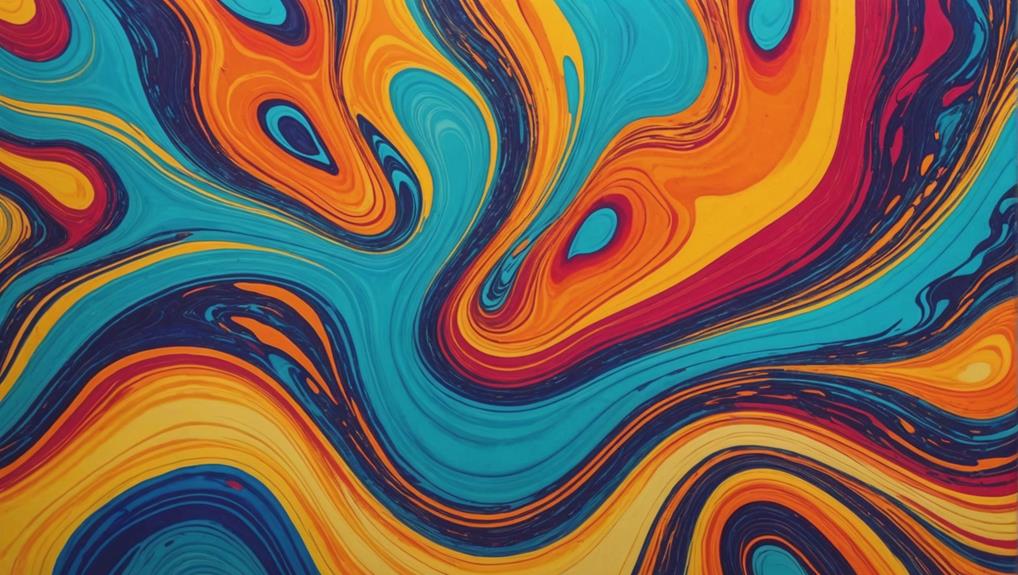
Building on the foundational experiments of David Alfaro Siqueiros, the evolution of pouring techniques in fluid art has been marked by continuous innovation and refinement. Siqueiros's early work with paint additives to alter viscosity and density provided a vital understanding of how different paints interact on the canvas. This pioneering spirit paved the way for contemporary artists to explore and expand upon these methods.
Artists today employ a variety of pouring techniques, each bringing unique challenges and opportunities for creativity. Notable techniques include:
- Dirty Pour: This method involves mixing multiple colors in a single cup before pouring, resulting in dynamic, intricate designs that highlight color theory principles.
- Flip Cup: Layered colors are poured into a cup and then flipped onto the canvas, creating a visually striking effect with depth and texture exploration.
- Puddle Pour: Paints are poured in separate puddles on the canvas and then tilted to mix, emphasizing fluid dynamics and color blending.
These evolving techniques allow artists to push the boundaries of fluid art, continually discovering new ways to manipulate paint and achieve enthralling results.
Dutch Pour Technique
The Dutch Pour Technique brings a burst of creativity to fluid art by mixing acrylic paints in separate cups before applying them to the canvas.
Artists often start with a white background to make the colors pop, then pour the paints in lines or puddles, using a hairdryer to craft intricate patterns and cells.
This method not only produces stunning, organic designs but also offers endless possibilities for unique visual effects.
Paint Mixing Process
How does the meticulous paint mixing process in the Dutch Pour Technique contribute to the creation of vibrant, fluid art? The answer lies in the careful balance of paint viscosity and color harmony. By mixing acrylic paints in separate cups, artists can achieve the perfect consistency for fluidity, guaranteeing that the colors flow seamlessly across the canvas. This process is vital for the Dutch Pour Technique, where the interaction of colors relies heavily on their individual viscosities.
The steps involved are both methodical and creative:
- Selecting colors: Artists choose a palette that maintains a harmonious balance, guaranteeing that the hues complement each other rather than clash.
- Adjusting viscosity: Each paint is mixed with a pouring medium to achieve the desired thickness, which is essential for smooth, controlled pours.
- Adding silicone: To create cells, a few drops of silicone oil are added to the paint, aiding in the formation of intricate patterns.
These steps guarantee that the final artwork is not only visually striking but also maintains the organic, fluid essence that defines the Dutch Pour Technique.
Creating Visual Patterns
Artists employing the Dutch Pour Technique harness the fluid dynamics of acrylic paints to create visually stunning, organic patterns on their canvases. By mixing paints in separate cups, they can pour them onto a typically white, pre-coated canvas in lines or puddles. These paints are then manipulated using a hairdryer, creating delicate patterns and cells that captivate the eye with their intricate designs and vibrant colors. The technique leverages the natural fluid movement of the paint, emphasizing visual aesthetics and pattern recognition.
To enhance the formation of cells, artists may heat the paint with a hairdryer or add silicone to the mixture. This ability to generate unique, unpredictable designs with minimal tools—just paint and a heat source—has made the Dutch Pour Technique a favorite among fluid artists. The resulting artwork often features organic, almost otherworldly patterns that seem to dance and flow across the canvas.
Here's a quick overview of the key components of the Dutch Pour Technique:
| Component | Description | Purpose |
|---|---|---|
| Acrylic Paints | Mixed in separate cups | Achieve vibrant colors |
| Hairdryer | Used to manipulate the paint | Create delicate patterns |
| Silicone | Optional addition to paint mixture | Enhance cell formation |
This approach guarantees each piece is a unique exploration of fluid dynamics and artistic expression.
Puddle Pour Flip Cup
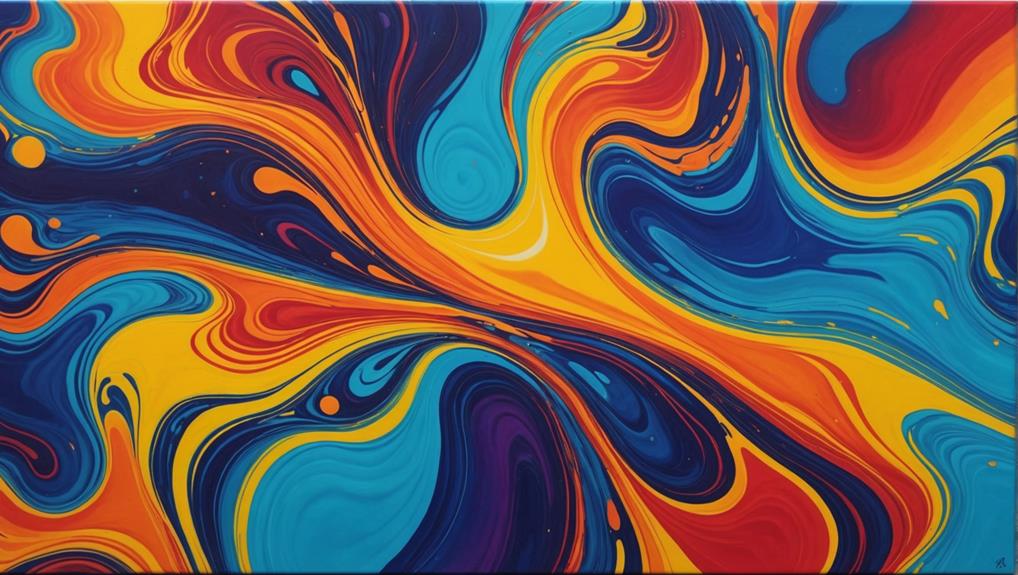
Employing the Puddle Pour Flip Cup method allows artists to create intricate and dynamic patterns by layering multiple colors in a cup before flipping it onto the canvas. This method highlights the importance of layering techniques and selecting harmonious color combinations to achieve depth and visual interest.
Artists typically start with a base color and add smaller amounts of other hues, often incorporating white to enhance contrast and vibrancy. The process involves flipping the cup onto the canvas to release the paint, ensuring a smooth distribution and natural blending of colors. The gentle movement of the canvas is essential to achieve an even spread and desired effects, which can result in unique and enchanting patterns.
Key aspects of the Puddle Pour Flip Cup method include:
- Layering multiple colors in a cup: This technique creates depth and interesting visual effects.
- Using three to four colors: This number is ideal for achieving a balanced and dynamic composition.
- Incorporating white: White paint can enhance contrast and make other colors pop.
This approach is favored by fluid artists for its ability to produce engaging and intricate designs, making it a staple in the world of fluid art.
Dirty Pour Technique
While the Puddle Pour Flip Cup method emphasizes layering, the Dirty Pour Technique focuses on the spontaneous and dynamic blending of colors within a single cup. This method involves mixing multiple colors of acrylic paint with a medium in one cup, creating a vibrant and dynamic blend. When the paint is poured onto the canvas in a single motion, it results in fluid consistency and unpredictable results that highlight the fascinating interaction of the colors.
One of the exciting aspects of the Dirty Pour Technique is its inherent unpredictability. The colors merge and flow in unexpected ways, leading to intricate patterns and vibrant designs that can be both mesmerizing and unique. To further enhance these effects, artists often rotate the canvas after the pour, distributing the paint evenly and revealing even more complex interactions between the colors.
Unlike the Flip Cup method, which relies on deliberate layering, the Dirty Pour Technique celebrates the natural flow and blending of colors, governed by the principles of Fluid Dynamics. This approach allows artists to create stunning, complex designs that showcase the beauty of spontaneous color interaction, making each piece truly one-of-a-kind.
Materials and Additives
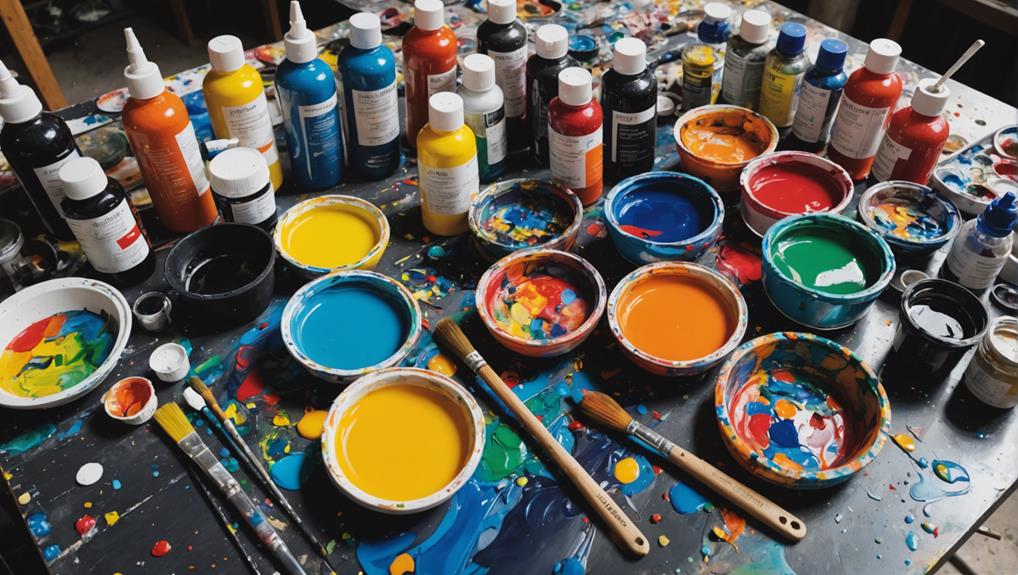
To achieve the best results in fluid art, a thorough understanding of the essential materials and additives is critical. The primary materials include acrylic paints, a medium such as Floetrol or PVA glue, and a well-prepared canvas. The preparation of the canvas is imperative for a successful outcome, guaranteeing a smooth surface for the paint to flow.
The viscosity of the paint plays a significant role in fluid art. Adjusting the paint viscosity using mediums guarantees the paint flows evenly and mixes well. Additives like silicone are often used to enhance cell visibility and improve flow, facilitating intricate patterns known as cell formation.
For accurate results, a digital scale is recommended to weigh paint precisely, allowing for consistent mixtures. Different grades of paint, ranging from low to professional, can influence the artwork's final appearance, with professional grades offering richer colors and better consistency.
Understanding paint density is also important as it affects layering and mixing. Heavier pigments tend to sink, while lighter pigments float, allowing artists to achieve desired effects in their creations.
- Acrylic paints
- Floetrol or PVA glue
- Silicone additives
Scientific Contributions
The collaboration between artist Sandra Cetina and physicist partners has considerably advanced the understanding of fluid dynamics in the context of fluid art. By integrating scientific methods into their practice, they explored how density and viscosity effects influence paint behavior during pouring. Their research meticulously measured the distance from the canvas during pouring, revealing fascinating patterns and effects that emerged from this variable.
Cetina and her team conducted numerous experiments, adding various oils and lacquer to paint mixtures. This enabled them to investigate how these additives impacted viscosity and the formation of cells, those intriguing bubble-like structures that often appear in fluid art. Their findings were groundbreaking, shedding light on how different paint properties can dramatically alter the final artistic outcome.
These scientific contributions underscore the remarkable intersection of art and science. By applying principles of fluid dynamics, Cetina's work demonstrates how scientific methods can enhance artistic techniques, leading to more controlled and predictable results. The collaboration has not only enriched the field of fluid art but also opened up new avenues for artists to experiment and innovate, underscoring the profound synergy between these two disciplines.
Fluid Dynamics in Art
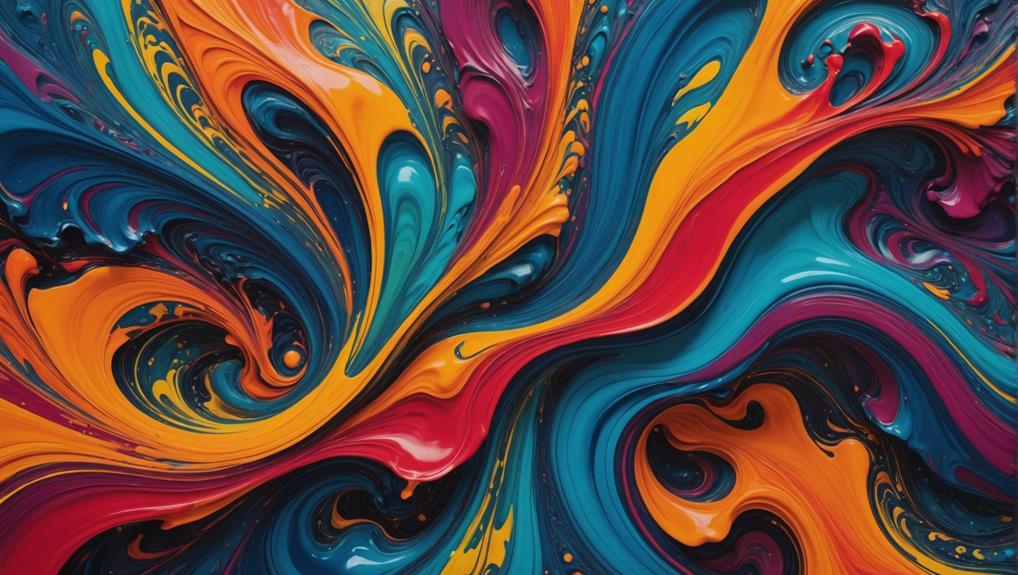
Fluid dynamics plays a pivotal role in fluid art, influencing how paints move and interact to create distinctive patterns and textures. By understanding the principles of liquid movement and pigment interaction, artists can achieve remarkable effects in their work. The study of fluid dynamics explains how various factors such as paint density and viscosity determine the behavior of paints during the pouring process.
For instance, heavier pigments tend to sink while lighter ones float, creating mesmerizing layers and intricate designs. The addition of substances like silicone or Floetrol alters the viscosity of the paints, enhancing their flow characteristics and enabling artists to control the interaction of colors on the canvas.
- Paint Density: Heavier pigments sink, allowing for layering effects.
- Viscosity Additives: Substances like silicone change paint flow.
- Cell Creation: Manipulating density and viscosity to form dynamic cells.
These elements help artists push the boundaries of fluid art, transforming simple liquid movement into complex, beautiful compositions. By mastering the nuances of fluid dynamics, artists can predict and control the behavior of their materials, achieving desired results with greater precision and creativity.
Modern Fluid Art Trends
In what ways have modern fluid art trends evolved with the influence of social media and innovative materials? Social media influence has greatly shaped the modern fluid art landscape, allowing artists to share their creative processes and final masterpieces with a global audience. Platforms like Instagram and TikTok have democratized access to fluid art techniques, igniting a surge in popularity and creativity. Moreover, the use of innovative additives like treadmill belt lubricant and specialized silicone has revolutionized the creation of intricate cells and patterns, pushing the boundaries of what is possible in fluid art.
Artists are also experimenting with unconventional surfaces beyond traditional canvases. Materials such as wood, tiles, and glass are being utilized to expand the scope and versatility of fluid art. Additionally, there is a growing trend towards eco friendly practices. The use of non-toxic and sustainable paints reflects a heightened awareness of environmental impact within the art community.
Below is a table summarizing key modern fluid art trends:
| Aspect | Description | Impact |
|---|---|---|
| Social Media Influence | Platforms for showcasing and learning | Increased accessibility and popularity |
| Innovative Additives | Materials like silicone and lubricants | Enhanced cell and pattern creation |
| Unconventional Surfaces | Using wood, tiles, glass | Expanded artistic possibilities |
| Eco Friendly Practices | Use of non-toxic, sustainable paints | Reduced environmental impact |
| Technique Experimentation | Varied methods like dirty pours and swipes | Encouraged creativity and experimentation |
These trends underscore the dynamic and evolving nature of modern fluid art.
Community and Workshops
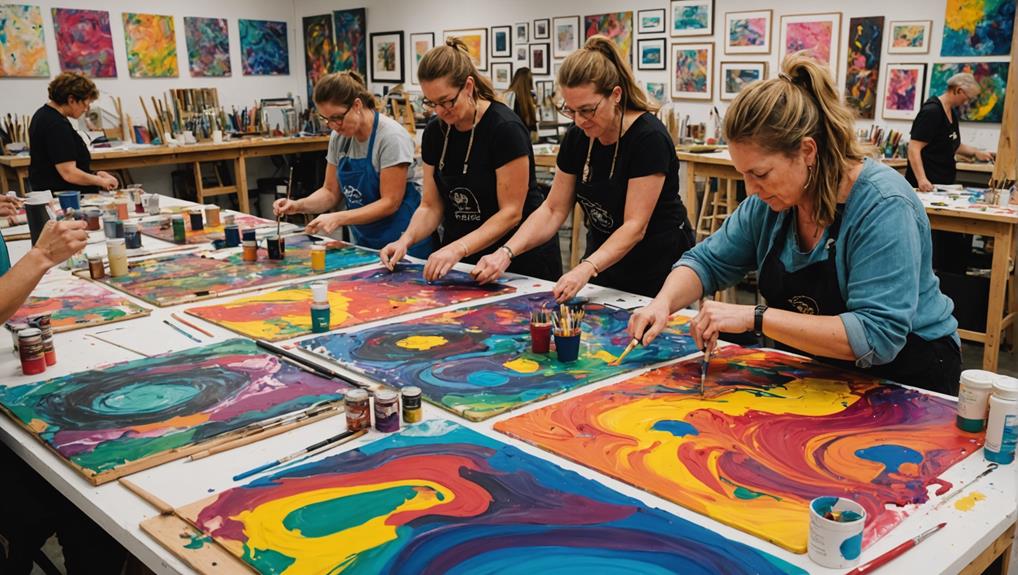
Modern fluid art trends have not only transformed individual practices but have also fostered vibrant communities and educational workshops that facilitate hands-on learning and collaboration.
These gatherings are essential for artists of all levels, providing a platform for community engagement and personal growth.
For instance, the upcoming one-day workshops on acrylic pouring are scheduled for September 14-15, 2024, and January 4, 2025. Each session is limited to four students, ensuring personalized attention. Participants will create 3-4 small canvases daily, using shared supplies provided by the instructor. The workshops include all necessary materials, so attendees only need to bring their lunch.
- Personalized Attention: With a cap of four students per session, everyone gets the help they need.
- Hands-on Experience: Create multiple small canvases each day, perfecting your technique.
- Inclusive Materials: All supplies are provided, simplifying preparation.
Community engagement is further encouraged through the 3T Art Blog, which offers weekly updates and member feedback.
These workshops and online resources highlight the workshop benefits, fostering a supportive and interactive art community.
Frequently Asked Questions
What Is the History of Fluid Art?
Fluid art evolution began in the 1930s with David Alfaro Siqueiros's innovative techniques, which were later advanced by Jackson Pollock. This movement has continually evolved, incorporating modern artistic techniques and engaging diverse creative communities.
What Is the History of Drip Art?
Drip art, popularized by Jackson Pollock in the 1940s and 1950s, utilizes drip techniques to create dynamic patterns. Influenced by David Alfaro Siqueiros, this method highlights the physical act of painting, evolving with contemporary artistic influences.
What Is the Science Behind Fluid Art?
Fluid art combines color theory and viscosity effects, where paint density and mediums like Floetrol influence interactions. The sinking of heavier pigments and floating of lighter ones create layered patterns, enhancing visual complexity and aesthetic appeal.
What Is the Meaning of Fluid Art?
Fluid Art is a painting technique where free-flowing acrylic paints create abstract designs, utilizing methods like acrylic pouring. This art form embodies artistic expression, leveraging scientific principles to manipulate paint interactions and achieve dynamic, organic effects.
Conclusion
Fluid art has journeyed from its origins to modern trends, shaped by key figures and scientific advancements.
The contributions of David Alfaro Siqueiros, Jackson Pollock, and innovations in acrylic paints have left a lasting impact.
Techniques evolved, blending art with fluid dynamics, leading to contemporary practices and vibrant community workshops.
This dynamic field continues to inspire, demonstrating the enduring appeal and versatility of fluid art in the artistic landscape.

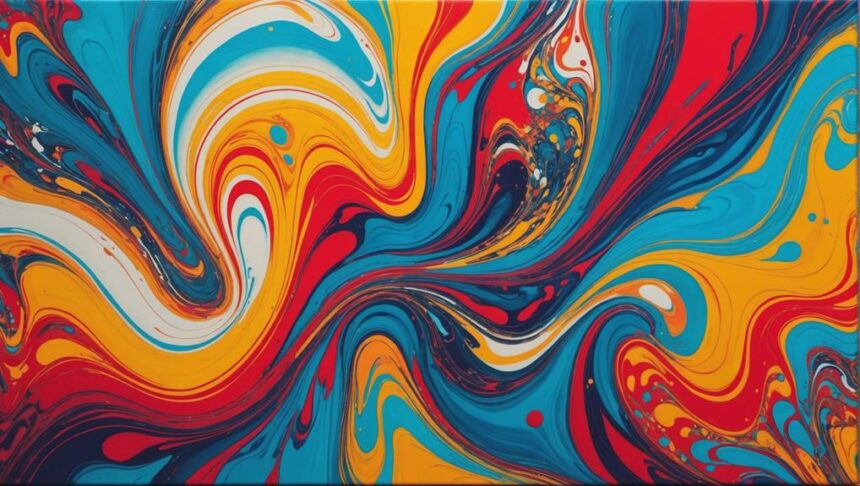
Leave a Reply